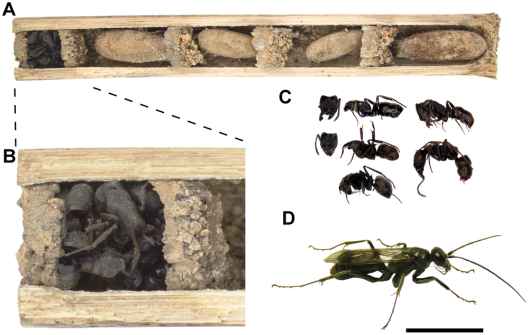The newly discovered Bone-house wasp, Deuteragenia ossarium, builds a unique nest for its young. Unlike species which excavate their own nests, D. ossarium belongs to a group of nest-building wasps which use existing cavities, such as abandoned galleries of wood-boring beetles, as nest sites. Female wasps abandon their nests after sealing their brood within; they don’t care for their young or offer any protection beyond what the nest provides. The nest consists of a few brood-containing cells and an outer ‘vestibular’ cell — an entryway — which probably serves as a defensive barrier. The vestibule is usually empty, but researchers surveying nests in southeast China found a surprise in some of the entry halls — they were full of ant corpses. The team reared the brood from the nests and discovered a new wasp species, which they named after the striking ossuaries found in some parts of the world.
Why does the bone-house wasp do such an odd thing? What’s the point of blocking the nest entrance with dead ants? According to the team’s findings, the corpses protect the developing brood. Only 3% of the D. ossarium had parasites, while around 16% of the other nests the team found were parasitized. Ants use complex chemicals on their exoskeleton for communication and recognition; since the corpses are still coated with those chemicals, parasites and predators might mistake the nest for an ant colony and leave it alone. Lots of other species also use ants for protection — some spiders and butterflies, for example — but they usually disguise themselves and live within an ant colony. The bone-house wasp is unique in using ant carcasses to build a defensive structure. It’s a slightly macabre strategy, but I think it’s also a pretty amazing one!
Ref
Staab, M., Ohl, M., Zhu, C., & Klein, A. (2014). A Unique Nest-Protection Strategy in a New Species of Spider Wasp PLoS ONE, 9 (7) DOI: 10.1371/journal.pone.0101592


You must be logged in to post a comment.